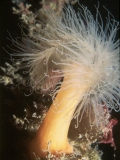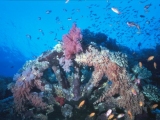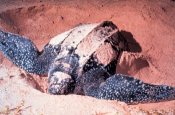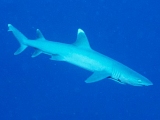Sunday, May 24, 2009
Protecting the oceans makes economic sense
 Protecting the oceans through marine protected areas can provide higher and more sustained income through tourism and controlled fisheries than continued exploitation. This is the result of IUCN’s new compilation of case studies about the economic benefits of marine protected areas, launched on World Biodiversity Day at the 2nd International Marine Protected Area Congress.
Protecting the oceans through marine protected areas can provide higher and more sustained income through tourism and controlled fisheries than continued exploitation. This is the result of IUCN’s new compilation of case studies about the economic benefits of marine protected areas, launched on World Biodiversity Day at the 2nd International Marine Protected Area Congress. “Marine protected areas, if well managed, help fish stocks replenish, which then increase yields in neighbouring areas and improve the economic situation of the local communities” says Carl Gustaf Lundin, Head of IUCN’s Global Marine Programme.
Marine protected areas also attract tourism, which is the other important source of income through marine conservation.
Since all fishing has been banned in the British Lundy Island No Take Zone, a small four square km marine protected area set up in the Bristol Channel in 2003, tourism has picked up significantly: the business of the area’s tour operator, for example, has doubled since 2003. The fishing industry also benefits from the Lundy No Take Zone: lobsters have become more abundant and grown in average size, within and outside the protected zone, which is expected to replenish fish stocks in the area and increase fisheries yields. (You can read the Lundy Island case study here.)
Less than one percent of the world’s oceans are currently protected, compared to about 12 percent of the land surface. Governments agreed under the UN Convention on Biological Diversity to increase protection of the oceans to 10 percent by 2010.
IUCN, the International Union for Conservation of Nature, is the world’s oldest and largest global environmental network - a democratic membership union with more than 1,000 government and non-government member organisations, and almost 11,000 volunteer scientists in more than 160 countries.
Related News:
Making Marine Protected Areas Work for Everyone
What do you think of this news item? Join a discussion.
Labels: environment, SCUBA News
Thursday, May 21, 2009
Endangered right whales found where they were thought extinct
 Using a system of underwater hydrophones that can record sounds from hundreds of miles away, a team of scientists has documented the presence of endangered North Atlantic right whales in an area they were thought to be extinct.
Using a system of underwater hydrophones that can record sounds from hundreds of miles away, a team of scientists has documented the presence of endangered North Atlantic right whales in an area they were thought to be extinct.The discovery is particularly important, researchers say, because it is in an area that may be opened to shipping if the melting of polar ice continues, as expected.
Results of the study were presented this week at a meeting of the Acoustical Society of America.
The scientists from Oregon State University and the National Oceanic and Atmospheric Administration are unsure of exactly how many whales were in the region, which is off the southern tip of Greenland and site of an important 19th-century whaling area called Cape Farewell Ground. But they recorded more than 2000 right whale vocalizations in the region from July to December of 2007.
“The technology has enabled us to identify an important unstudied habitat for endangered right whales and raises the possibility that – contrary to general belief – a remnant of a central or eastern Atlantic stock of right whales still exists and might be viable,” said David Mellinger, chief scientist of the project.
“We don’t know how many right whales there were in the area,” Mellinger added. “They aren’t individually distinctive in their vocalizations. But we did hear right whales at three widely space sites on the same day, so the absolute minimum is three. Even that number is significant because the entire population is estimated to be only 300 to 400 whales.”
Only two right whales have been sighted in the last 50 years at Cape Farewell Ground, where they had been hunted to near extinction prior to the adoption of protective measures.
The pattern of recorded calls suggests that the whales moved from the southwest portion of the region in a northeasterly direction in late July, and then returned in September – putting them directly where proposed future shipping lanes would be likely.
Right whales are the most endangered large whale and vulnerable to collisions with ships as they ignore general ship sounds. Alarm sirens intended to scare them away from ships may actually be more likely to cause a collision, as the whales have been shown to rush to the surface when they hear the alarm.
Related News:
Lawsuit Filed to Protect World's Most Endangered Whale
What do you think of this news item? Join a discussion.
Labels: research, SCUBA News, whale and dolphins
Manage corals and minimise climate change
 A better assessment of the threats to coral reefs along with improved management will give corals a much higher chance of survival in the face of warming oceans, says IUCN's latest report.
A better assessment of the threats to coral reefs along with improved management will give corals a much higher chance of survival in the face of warming oceans, says IUCN's latest report.“We already know that climate change is destroying coral reefs through warming waters that cause coral bleaching and through acidifying oceans that hinders coral skeleton growth. We also know that if we want to save these beautiful living entities we must do something about it immediately,” says Gabriel Grimsditch, IUCN Corals Expert.
The report, Resilience Assessment of Coral Reefs - Rapid assessment protocol for coral reefs, focusing on coral bleaching and thermal stress, shows that the amount of damage done to corals depends not only on the rate and extent of climate change, but also on the ability of coral reefs to cope with change. This report outlines a protocol that defines basic resilience indicators that can be quantified using rapid assessment methods.
The need for quick results for measuring coral reef resilience is becoming increasingly acute, especially in the developing world. It is crucial to develop monitoring and assessment protocols to build an understanding of bleaching resistance and resilience indicators for application in management, and to determine how Marine Protected Area management actions can influence resilience and resistance.
"Research assessment for coral reefs builds our understanding of past management actions in maintaining the resilience of coral reefs, and helps managers combat the effects of climate change,” says Carl Gustaf Lundin, Head of IUCN’s Global Marine Programme. “Greater investment must be made in using research findings for adaptive management.”
“The story of coral reefs is particularly powerful and compelling, being one of the first ecosystems to clearly show climate change impacts, and being well-understood, highly visible and charismatic,” adds Lundin. “As a result, increasing our knowledge base of resilience-based science, management and policy for coral reefs has broader value for other ecological and human systems globally.”
“Findings from coral reefs should be more efficiently incorporated into the United Nations’ climate change negotiations in Copenhagen in December.”
IUCN, the International Union for Conservation of Nature, is the world’s oldest and largest global environmental network - a democratic membership union with more than 1,000 government and non-government member organisations, and almost 11,000 volunteer scientists in more than 160 countries.
Read the report: Resilience Assessment of Coral Reefs - Rapid assessment protocol for coral reefs
What do you think of this news item? Join a discussion.
Labels: coral, coral reef, SCUBA News
Tuesday, May 19, 2009
New initiative to reduce shark deaths
 Today, the Shark-Marina, a not-for-profit company launches its strategy to prevent the deaths of millions of vulnerable and endangered species of shark. The initiative aims to win over the fishing community by working with game fishing societies, tackle manufacturers, competition sponsors and marinas to form community conscious policy.
Today, the Shark-Marina, a not-for-profit company launches its strategy to prevent the deaths of millions of vulnerable and endangered species of shark. The initiative aims to win over the fishing community by working with game fishing societies, tackle manufacturers, competition sponsors and marinas to form community conscious policy.In the last five years over half a million sharks on average were killed by the recreational and sport fishing community in the United States alone. Many of these were breeding age specimens and belong to vulnerable or endangered species.
The Shark-Free Marina Initiative works by prohibiting the landing of any caught shark at a participating marina. By promoting catch-and-release fishing the sport of shark fishing can actively participate in ongoing research studies and collect valuable data. The initiative is based on the Atlantic billfish model which banned the mortal take of billfish in response to population crashes in the 80's.
"Although the number of sharks killed by recreational fishermen each year is dwarfed by commercial catches, the current crisis facing shark stocks requires action wherever possible." says marine scientist and SFMI Advisor Edd Brooks "We are not asking fishermen to stop fishing, only asking them to start releasing their catch."
By collaborating with the Cape Eleuthera Institute in the Bahamas and the Fisheries Conservation Foundation in the USA, Shark-Free Marinas have already had an impact.
What do you think of this news item? Join a discussion.
Labels: sharks
Basking shark mystery solved
Once thought of as a strictly cool-water species, basking sharks migrate to tropical waters each winter, according to research published in the June 2009 issue of journal Current Biology.
"While commonly sighted in surface waters during summer and autumn months, the disappearance of basking sharks during winter has been a great source of debate ever since an article in 1954 suggested that they hibernate on the ocean floor during this time," said Gregory Skomal of Massachusetts Marine Fisheries. "Some 50 years later, we have helped to solve the mystery while completely re-defining the known distribution of this species."
Using new satellite-based tagging technology, the researchers found that basking sharks make ocean-scale migrations through tropical waters of the Atlantic Ocean during the winter, travelling at depths of 200 to 1,000 meters. Their data show that the sharks sometimes stay at those depths for weeks or even months at a time.
"In doing so, they have completely avoided detection by humans for millennia," Skomal said
The discovery was the result of marking 25 basking sharks off the coast of Cape Cod with satellite tags and studying their movements. The migratory paths of the sharks were then estimated by coupling tag data with a novel geo-positioning technology technique.
Several factors had made basking sharks a challenge to study. On top of the fact that they disappear for long periods of time, they also feed exclusively on plankton. That means they can't readily be captured with traditional rod-and-reel methods. And even when the sharks are found closer to the ocean surface, they spend their time in the cool-temperature, plankton-rich waters that limit underwater visibility and make diving difficult.
The basking shark is the second largest shark after the whale shark. It filters plankton through its gills whilst swimming with its huge mouth open.
Journal Reference:
Transequatorial Migrations by Basking Sharks in the Western Atlantic Ocean. Skomal, Gregory B.; Zeeman, Stephen I.; Chisholm, John H.; Summers, Erin L.; Walsh, Harvey J.; McMahon, Kelton W.; Thorrold, Simon R.
doi:10.1016/j.cub.2009.04.019
"While commonly sighted in surface waters during summer and autumn months, the disappearance of basking sharks during winter has been a great source of debate ever since an article in 1954 suggested that they hibernate on the ocean floor during this time," said Gregory Skomal of Massachusetts Marine Fisheries. "Some 50 years later, we have helped to solve the mystery while completely re-defining the known distribution of this species."
Using new satellite-based tagging technology, the researchers found that basking sharks make ocean-scale migrations through tropical waters of the Atlantic Ocean during the winter, travelling at depths of 200 to 1,000 meters. Their data show that the sharks sometimes stay at those depths for weeks or even months at a time.
"In doing so, they have completely avoided detection by humans for millennia," Skomal said
The discovery was the result of marking 25 basking sharks off the coast of Cape Cod with satellite tags and studying their movements. The migratory paths of the sharks were then estimated by coupling tag data with a novel geo-positioning technology technique.
Several factors had made basking sharks a challenge to study. On top of the fact that they disappear for long periods of time, they also feed exclusively on plankton. That means they can't readily be captured with traditional rod-and-reel methods. And even when the sharks are found closer to the ocean surface, they spend their time in the cool-temperature, plankton-rich waters that limit underwater visibility and make diving difficult.
The basking shark is the second largest shark after the whale shark. It filters plankton through its gills whilst swimming with its huge mouth open.
Journal Reference:
Transequatorial Migrations by Basking Sharks in the Western Atlantic Ocean. Skomal, Gregory B.; Zeeman, Stephen I.; Chisholm, John H.; Summers, Erin L.; Walsh, Harvey J.; McMahon, Kelton W.; Thorrold, Simon R.
doi:10.1016/j.cub.2009.04.019
What do you think of this news item? Join a discussion.
Labels: research, SCUBA News, sharks
Monday, May 18, 2009
World's Largest Leatherback Turtle Population Found
 An international team of scientists has identified a nesting population of leatherback sea turtles in Gabon, West Africa as the world's largest.
An international team of scientists has identified a nesting population of leatherback sea turtles in Gabon, West Africa as the world's largest.The research, published in the May issue of Biological Conservation, involved country-wide land and aerial surveys that estimated a population of between 15,730 and 41,373 female turtles using the nesting beaches.
The study highlights the importance of conservation work to manage key sites and protected areas in Gabon.
Leatherbacks are of profound conservation concern around the world after populations in the Indo-Pacific crashed by more than 90 percent in the 1980s and 1990s. The International Union for Conservation of Nature (IUCN) lists leatherback turtles as critically endangered globally, but detailed population assessments in much of the Atlantic, especially Africa, are lacking.
During three nesting seasons between 2002 and 2007, the team’s members carried out the most comprehensive survey of marine turtles ever conducted in Gabon. This involved aerial surveys along Gabon’s 600 km (372 mile) coast, using video to capture footage for evaluation, and detailed ground-based monitoring. By covering the entire coastline, they were not only able to estimate the number of nests and nesting females, but also to identify the key sites for leatherback nesting, data which are crucial to developing conservation management plans for the species. Leatherbacks were first described nesting in Gabon in 1984.
The study also revealed that around 79 percent of the nesting occurs within National Parks and other protected areas. This gives added hope that Gabon can continue to be one of the world’s most important countries for these magnificent creatures.
Dr Angela Formia of the Wildlife Conservation Society, a co-author of the paper, said: “These findings show the critical importance of protected areas to maintain populations of sea turtles. Gabon should be commended for creating a network of National Parks in 2002 that have provided a sanctuary for this endangered species as well as other rare wildlife.”
The leatherback is the largest sea turtle, reaching up to nearly two metres (6.5 feet) in length and 540kg (1190 pounds) in weight. Unlike other sea turtles, the leatherback does not have a hard shell. Its shell is made-up of a mosaic of small bones covered by firm, rubbery skin with seven longitudinal ridges. Leatherbacks are the most widely spread marine turtles, and are found in the Pacific, Indian and Atlantic oceans, particularly in tropical regions. They are also the deepest diving of all sea turtles. The deepest recorded dive is 1.2 kilometres (3/4 mile), which is slightly more than the deepest known dive of a sperm whale.
As with other reptiles, the sex of leatherbacks is determined by the temperature of eggs during incubation. With leatherbacks, temperatures above 29 degrees centigrade (84 degrees Fahrenheit) will result in female hatchlings.
Leatherbacks are strong swimmers and tagged individuals have been known to cross ocean basins and are known to travel many thousands of kilometres in search of their jellyfish prey.
To see turtles currently being tracked from Gabon see: http://www.seaturtle.org/tracking/?project_id=340
The research was led by the University of Exeter working in collaboration with the Wildlife Conservation Society (WCS) which spearheads the Gabon Sea Turtle Partnership, a network of organisations concerned with the protection of marine turtles in Gabon.
Related News:
California waters for leatherback turtles?
What do you think of this news item? Join a discussion.
Labels: Africa, research, SCUBA News, sealife, turtles
Wednesday, May 06, 2009
Caribbean Big Fish Disappearing
 Sharks, barracuda and other large predatory fishes disappear on Caribbean coral reefs as human populations rise, endangering the region's marine food web and ultimately its reefs and fisheries, according to a study published today in the journal PLoS One.
Sharks, barracuda and other large predatory fishes disappear on Caribbean coral reefs as human populations rise, endangering the region's marine food web and ultimately its reefs and fisheries, according to a study published today in the journal PLoS One.While other scientists working in the Caribbean have observed the declines of large predators for decades, the new study by Chris Stallings documents the ominous patterns geographically in much more detail than other research to date.
“I examined 20 species of predators, including sharks, groupers, snappers, jacks, trumpetfish and barracuda, from 22 Caribbean nations,” said Stallings, a postdoctoral associate at the FSU Coastal and Marine Laboratory. “I found that nations with more people have reefs with far fewer large fish because as the number of people increases, so does demand for seafood. Fishermen typically go after the biggest fish first, but shift to smaller species once the bigger ones become depleted. In some areas with large human populations, my study revealed that only a few small predatory fish remain.”
Stallings said that although several factors — including loss of coral reef habitats — contributed to the general patterns, careful examination of the data suggests overfishing as the most likely reason for the disappearance of large predatory fishes across the region. He pointed to the Nassau grouper as a prime example. Once abundant throughout the Caribbean, Nassau grouper have virtually disappeared from many Caribbean nearshore areas and are endangered throughout their range.
“Large predatory fish such as groupers and sharks are vitally important in marine food webs,” Stallings said. “However, predicting the consequence of their loss is difficult because of the complexity of predator-prey interactions. You can't replace a 10-foot shark with a one-foot grouper and expect there to be no effect on reef communities. Shifts in abundance to smaller predators could therefore have surprising and unanticipated effects. One such effect may be the ability of non-native species to invade Caribbean reefs.”
A case in point, said Stallings, is the ongoing invasion by Pacific lionfish, which were introduced by aquarium releases.
“Lionfish are minor players on their native Pacific reefs, yet they are undergoing a population explosion and overeating small fishes in the greater Caribbean region,” said Professor Mark Hixon of Oregon State University, Stallings' doctoral advisor at OSU. “Preliminary evidence suggests that lionfish are less invasive where large predatory native fishes are abundant, such as in marine reserves,” Hixon said.
The study also demonstrates the power of volunteer and community research efforts by non-scientists. Stallings used data from the Reef Environmental Education Foundation's (REEF) online database, which contains fish sightings documented by trained volunteer SCUBA divers, including more than 38,000 surveys spanning a 15-year period.
Further Reading:
Fish predators of the Caribbean: the curse of too many people, Florida State University
Fishery-Independent Data Reveal Negative Effect of Human Population Density on Caribbean Predatory Fish Communities, PLoS One
What do you think of this news item? Join a discussion.
Labels: Caribbean, research, SCUBA News, sharks